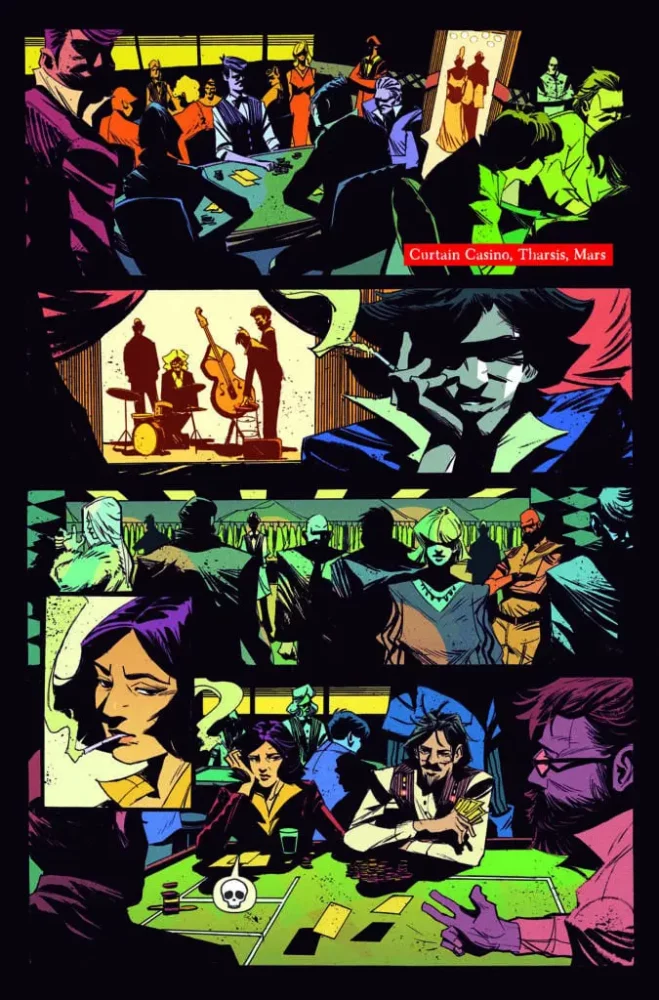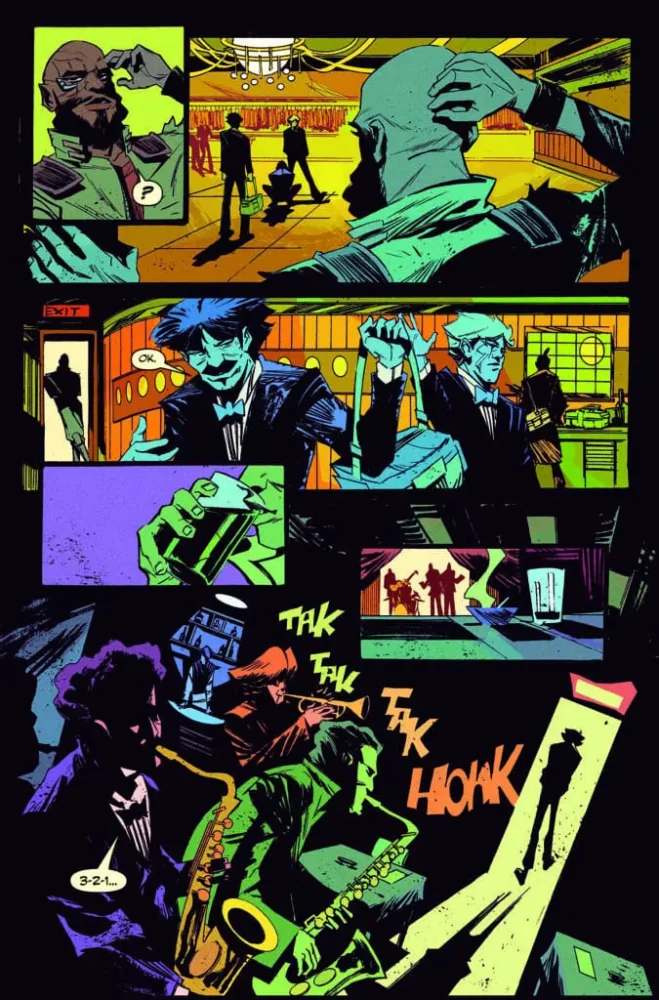There’s scarcely a more convoluted source for an adaptation than Titan Comics’ Cowboy Bebop: Supernova Swing. This 4-issue mini-series penned by Lucifer and Sword of Azrael writer Dan Watters and drawn by up-and-coming phenom Lamar Mathurin is technically a tie-in to the atrocious and deservedly cancelled Netflix adaptation of Shinichiro Watanabe’s masterpiece anime. Fortunately, what makes this comic work so well is how much its creators understand what truly makes the original source material tick – and how much they decided to ignore the live-action series they were tied to. Both a thorough understanding of what made Watanabe’s masterwork such an influential piece of art and the creative team’s comics-making synergy propel this mini-series into the stratosphere as not just a create comic, but one of the best adaptations ever put to page.
Originally released in 1998, Shinichiro Watanabe and Sunrise Studio’s Cowboy Bebop still stands tall as one of the greatest works in the medium of animation. Watanabe’s influences from Western cinema bleed into this 26-episode cyberpunk tale of a crew of desperate bounty hunters and the strange situations they end up in. The series’ use of music remains one of the best blends of cinema and song in both animation and film. While the show on the whole does have an episodic structure for long stretches, its main story beats are filled with an existential weight that still hangs heavy on viewers years after wrapping its final episode. Bebop is an undeniable peak in anime and the medium of animation as a whole. So how does a creative team follow that influence into the comics medium? Especially when tying said comic to a live-action show that missed the mark completely? There’s been a Bebop comic before, in the form of a decent but forgettable manga. The key to making a great adaptation comes down to having a thorough understanding of the source material, while also being a brilliant creative force in your own medium.
Cowboy Bebop: Supernova Swing follows the crew of the Bebop – Spike Spiegel, Faye Valentine, Jet Black, and Ein the genius corgi (Ed hadn’t been introduced in the Netflix series yet) as they go after a mark named Melville. As with every Bebop bounty, there’s a catch: Melville is supposedly wearing a “quantum probability vest,” granting him an unlimited amount of luck and making him impossible to catch. Each issue sees the crew in a different snag, from escaping a laziness-poisoned planet or fighting other bounty hunters in a flying delivery truck. This mini-series feels exactly like a lost episode of the original anime, transcribed into the comics medium. A huge part of this is due to how writer Dan Watters clearly understands every facet of Cowboy Bebop. The very plot itself fits right in as such a distinctive Bebop story. Each crewmember’s distinct personality is nailed down in these pages; Spike’s distant nonchalance with sudden explosions of determination, Faye’s reckless confidence, and Jet’s guarded paternalism are straight out of the original series. What’s more here though is that Watters hits the thematic elements and story arc structure of Bebop on the head. Each issue features the property’s signature style of humor and swinging, noir-esque dialogue punctured that fans know and love and that newcomers will be seduced by. Watters also understands how the small moments are so huge in Bebop – how many of the original’s key moments were just small, deeply meaningful conversations that added into the show’s overall thematic tone. Each one of the crew has a talk with a new character that leaves a noticeable impression on them, and that influences their moves in subsequent scenes. These moments in turn leave an impression on the reader. Dan Watters understands Cowboy Bebop, and has given fans old and new a story that is one-hundred percent a representation of the tone and feel of the original show.
MFR ON YOUTUBE (latest video)
Help us reach 5K Subs!
All of the praise over Watters’ scripts would be meaningless if the visual team didn’t capture Cowboy Bebop’s original atmosphere. Lamar Mathurin and the incredible work of color artists Roman Titov and Emilio Lecce succeed at crafting an experience in Supernova Swing that looks and feels like Watanabe & Co.’s original work, but is also entirely distinct. Due to the comic’s ties to the Netflix series, Mathurin does stick to that show’s cast as visual reference to the crew in this book. However, this is almost unnoticeable for the most part, save for the difference in Faye’s outfit. This mini-series abides by the visual language of the anime with the loose postures and characters designs, focus on character interactions, and the overall used-future look of the setting. The urban environments are full of debris and people just trying to get by, while the remote settlement of Cyllene feels like a place society forgot. Mathurin and the rest of the art team do a wonderful job of reminding readers what Bebop has always in some form been about – the people you meet who leave an impression on you. Every interaction in this comic has a depth that stays in the reader’s mind throughout the whole issue. The action and movement are exhilarating and in line with the loose, jazzy feel of the series as well. Mathurin nails the animation behind Spike’s Jeet Kune Do martial arts, to the point where you can almost hear the music in the background while the fists and feel fly. The absurdity of some situations – like a delivery van full of spicy noodles being towed by a spaceship while a fight breaks out on board – is both inescapably comics and anime. Even the lettering, crafted beautifully by Richard Starkings and Jimmy Betancourt, becomes a part of the overall storytelling environment in a way that somehow just *feels* Bebop. The outstanding hand-lettered look of the dialogue is impressive on its own, but it’s joined by artistically brilliant SFX lettering that looks like it naturally belongs in the space alongside the action. Supernova Swing has visuals that understand the source material as well as the script, perfecting this stellar adaptation.
Cowboy Bebop: Supernova Swing is a masterful adaptation because it seamlessly turns the iconic anime’s style into a comic book. From the overall plot to the minutiae of its quieter moments, Dan Watters shows that he understands the fundamental aspects of what makes Bebop tick and delivers what could easily be a lost script from Watanabe & Co.’s original work. The artistic vision made by Lamar Mathurin’s pencils with Roman Titov and Emilio Lecce’s colors is reminiscent of the source material while still crafting a sleekness and swagger all its own. Despite its attachment to a messy, failed live-action adaptation, this four-issue mini-series is an absolute must-read for Bebop fans and readers of stylish comics alike.

